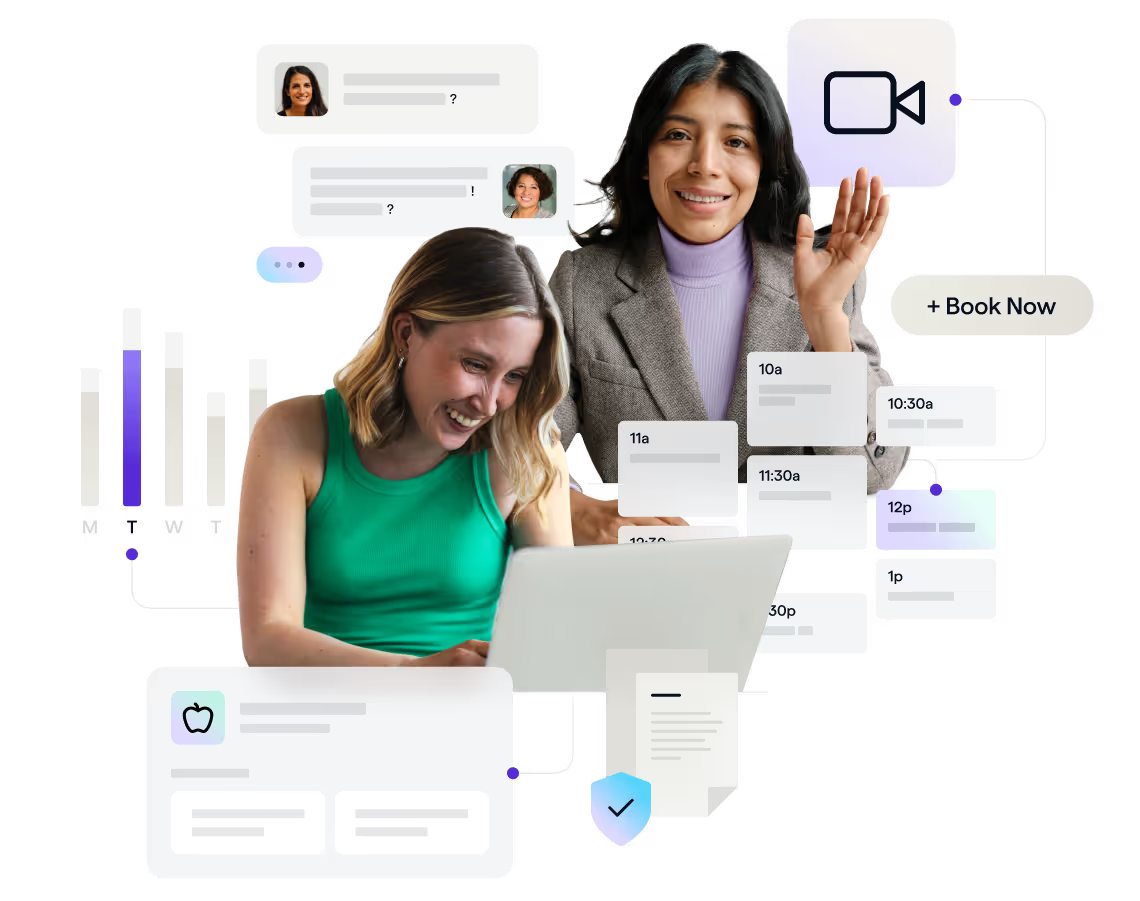

What’s next in AI-driven care delivery? 5 use cases we’re watching
Explore five emerging use AI cases in healthcare that will redefine how care is delivered, scaled, and experienced.
Beyond the Scribe: The Next Horizon of AI in Care
The first wave of AI in healthcare focused on documentation — voice-to-text tools and AI scribes were adopted across specialties and care settings. It proved that automation can reduce cognitive load, return valuable time to clinicians, and deliver measurable impact. Yet these tools address only one part of the care delivery experience. The next horizon of AI goes deeper. It's not just about reducing administrative work — it’s about making more intelligent, personalized, and safe care at scale.
At Healthie, we work hand-in-hand with thousands of clinicians and healthcare organizations, giving us insight into how care is evolving and where AI can drive the most value. Through ongoing conversations with our Clinical Advisory Council, enterprise partners, and front-line providers, we’ve seen clear needs emerge: the shift toward longitudinal care models, the importance of cross-functional coordination, and the urgent demand to unlock insights trapped in fragmented systems.
These insights aren’t theoretical, they come directly from the daily challenges our customers face. As AI matures, we believe the next generation of tools must go beyond documentation and tackle these deeper complexities head-on. The five use cases below represent where we see AI truly transform care delivery — not just making it more efficient, but more intelligent, proactive, and personalized.
The next generation of AI solutions will be built on this foundation, with infrastructure designed to support real-time, client-specific actions that drive better outcomes. Here are five AI use cases we’re watching closely as signals of what’s coming next in care delivery to help teams assess risk, guide decisions, engage clients more effectively, and extend care beyond the visit.
1. Real-time clinical decision support that drives clinical excellence at scale.
Today’s clinical decision support (CDS) tools often rely on static rules, limited context, and legacy EHR integrations, meaning they’re often ignored in practice, as alert fatigue, poor accuracy, or irrelevant suggestions can make them more noise than signal. AI changes this.
By analyzing structured and unstructured data across assessments, vitals, labs, care plans, and engagement, AI systems can surface recommendations tailored to the individual, not just the diagnosis.
For example, a model could suggest a clinical approach based on recent trends and lab results — or flag a care plan that deviates from clinical guidelines. Over time, these models can learn from outcomes and clinician feedback to refine their accuracy and relevance.
This next generation of CDS systems extends beyond static rules engines — ingesting data across populations and individuals to surface next-best actions in real time — and tailoring them to the specific context of the client and the care plan.
The value here is substantial. Studies have shown that effective CDS tools can significantly reduce diagnostic errors and lower adverse drug events. With AI, there is an opportunity to increase care precision and personalization — while reducing the mental overhead clinicians face every day.
2. Surfacing critical data trends into actionable clinical signals for proactive care.
AI thrives on data — but what truly sets AI apart in healthcare is its ability to make sense of patterns across time.
For clients managing chronic or complex conditions, insights rarely come from a single data point. Instead, patterns emerge over weeks, months, or even years — they unfold over time. Is someone’s weight fluctuating alongside medication changes? Are periods of low engagement a leading indicator of relapse or readmission? Traditional care systems aren’t built to surface these insights, but AI models are.
By analyzing longitudinal patterns — changes in engagement, shifts in sentiment, variations in biometric data — emerging tools can detect subtle or early signs of risk long before a crisis hits. This allows care teams to shift from reactive to proactive care models, leading to earlier risk stratification, more targeted interventions, and improved resource allocation.
The stakes are high: According to McKinsey, AI-enabled care management could drive over $200 billion in annual healthcare savings through avoided hospitalizations and improved chronic condition management.
We know most AI systems operate on snapshot data — but health is inherently longitudinal. When AI can analyze trends and context over time, it becomes a powerful tool for detecting risk early and guiding proactive interventions.
3. Real-time risk detection and intelligent flagging to enable timely, high-impact interventions.
When a client is in crisis, every minute matters. But across behavioral health and chronic care delivery, many clinicians still lack tools to detect or respond to risk signals in real time with the right level of support, documentation, and care coordination.
Generative AI is emerging as a valuable assessment tool for these moments. Imagine a system that scans a session note or self-reported check-in and flags escalating risk — then instantly generates a customized safety plan draft, complete with local crisis resources, contact information, and follow-up protocols. These tools can serve as real-time co-pilots. Clinicians still lead the intervention, but AI reduces the time and effort required to respond effectively.
This isn’t just a nice-to-have. The CDC reports that 85% of people who die by suicide see a provider in the year prior, yet many warning signs go unnoticed or unaddressed. AI-assisted tools can help close this gap by reducing time-to-intervention and standardizing best practices across teams to ensure no client falls through the cracks.
4. Intelligent scheduling that prioritizes clinical value and optimizes care team efficiency.
In most care settings, availability and client preference, not clinical impact, drives scheduling. But as clinician bandwidth shrinks and client complexity grows, AI is opening the door to smarter, more strategic scheduling.
Instead of routing based on open slots, systems can analyze care plan progress, risk signals, and engagement trends to identify which clients need priority support most — and when.
This shift matters: AI-driven scheduling tools have been shown to reduce no-shows and improve continuity, particularly for high-risk clients. Poor scheduling optimization costs the U.S. healthcare system an estimated $150 billion annually in missed appointments and inefficient care.
For care teams, AI scheduling tools mean fewer fire drills and manual triage. And for clients, it can mean faster intervention, stronger outcomes, and care that feels truly personalized — delivered when and where it matters most.
5. AI-powered engagement that reinforces care plan adherence and improves outcomes across populations.
As asynchronous and group-based care programs scale — from diabetes prevention to maternal health — maintaining meaningful engagement and momentum becomes exponentially harder. Dropout rates are high, and adherence is often inconsistent.
AI can now act as a behind-the-scenes coach, driving timely, personalized micro-interventions that reinforce behavior change between sessions. Whether it’s encouraging completion of a missed meal log, surfacing relevant content after a setback, or celebrating a milestone, these digital nudges can increase program retention without adding to the care team workload.
By layering AI-powered intelligent outreach into scalable programs, organizations can extend their presence and improve clinical outcomes — without adding hours or headcount.
Why Infrastructure Matters: Healthie Is Built for AI-First Care
The promise of AI in care delivery isn’t just about automation — it’s about transformation. From reducing clinician burnout, improving patient safety, and expanding access to care, these emerging use cases point toward a smarter, faster, and more responsive healthcare system.
The use cases above highlight what’s possible when AI is deeply integrated into care delivery, but this transformation can’t happen on outdated systems. Healthie was purpose-built for intelligence. Our API-first infrastructure, GraphQL-based data architecture, and modular tooling allow AI agents to interact directly with structured, longitudinal client data — enabling real-time, intelligent workflows that drive better outcomes.
Unlike legacy EHRs retrofitting AI onto rigid systems, Healthie offers a composable platform where intelligence isn’t bolted on — it’s built in. Whether you're developing your own models, deploying AI-powered engagement tools, or layering decision support across care programs, Healthie gives you the flexibility, security, and extensibility to bring those innovations to life.
In the next era of healthcare, AI won’t just enhance care — it will orchestrate it. And Healthie is the infrastructure that makes it possible.






